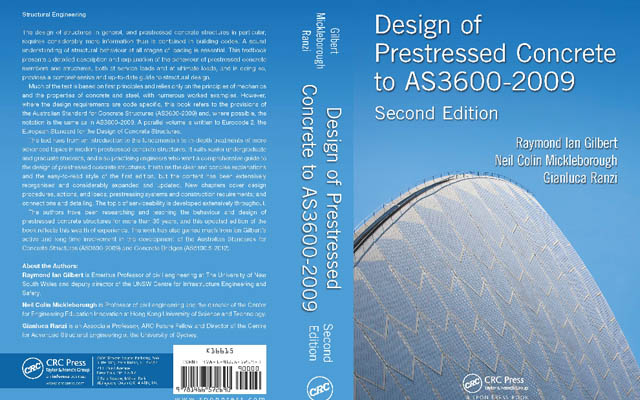NEW BOOK, Provides a unique focus on the treatment of serviceability aspects of design.
 Design of Prestressed Concrete to AS3600-2009
Design of Prestressed Concrete to AS3600-2009
Emeritus Professor Ian Gilbert, Deputy Director of the Centre for Infrastructure Engineering and Safety, has just had the second edition of his book Design of prestressed Concrete to AS3600-2009 published by CRC Press in Florida, USA. The book is co-authored with Professors Neil Michleborough (Hong Kong University of Science and Technology) and Gianluca Ranzi (University of Sydney).
The first edition of the book was published almost 25 years ago, so a comprehensive update and revision was long overdue. This edition contains the most up-to date and recent advances in the design of modern prestressed concrete structures, as well as the fundamental aspects of prestressed concrete behaviour and design that were so well received in the first edition. The text is written for senior undergraduate and postgraduate students of civil and structural engineering, and also for practising structural engineers. It retains the clear and concise explanations and the easy-to-read style of the first edition.
Much of the text is based on first principles and relies only on the principles of mechanics and the properties of concrete and steel, with numerous worked examples. However, where the design requirements are code specific, the book refers to the provisions of the Australian Standard for Concrete Structures AS3600-2009 and, where possible, the notation is the same as in AS3600-2009. A companion edition in accordance with the requirements of the European standard (EN 1992-1-1:2004 -Eurocode 2) is expected to be published in early 2016.
As in the first edition, the book provides a unique focus on the treatment of serviceability aspects of design. Concrete structures are prestressed to improve behaviour at service loads and thereby increase the economical range of concrete as a construction material. In conventional prestressed structures, the level of prestress and the position of the tendons are usually based on considerations of serviceability. Practical methods for accounting for the non-linear and time-dependent effects of cracking, creep, shrinkage, and relaxation are presented in a clear and easy-to-follow format.
The work has gained much from the membership of Professor Gilbert on committees of Standards Australia and the American Concrete Institute and his involvement in the development of AS 3600-2009 over the past 35 years. Design of Prestressed Concrete to AS3600-2009 will be a valuable source of information and a useful guide for students and practitioners of structural design.



